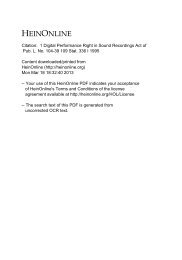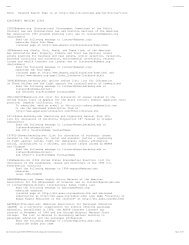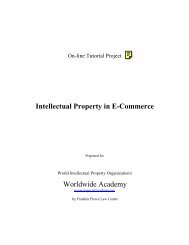BIEDERMANN MOTECH GMBH and Depuy Spine, Inc, Plaintiffs
BIEDERMANN MOTECH GMBH and Depuy Spine, Inc, Plaintiffs
BIEDERMANN MOTECH GMBH and Depuy Spine, Inc, Plaintiffs
You also want an ePaper? Increase the reach of your titles
YUMPU automatically turns print PDFs into web optimized ePapers that Google loves.
Thus, one might conclude that the Federal Circuit was merely extracting the gestalt of "compression<br />
member" from several claims in order to decide the question of whether "compression member" was<br />
intended to be a means-plus-function limitation, <strong>and</strong> thus one might conclude that a proper definition of<br />
"compression member" might leave out the limitations quoted above. See <strong>Depuy</strong> <strong>Spine</strong>, 469 F.3d at 1023<br />
(referring to "the claim language" rather than claim 1 explicitly).<br />
There are two problems with this conclusion.<br />
The first problem is perhaps minor. The Federal Circuit explicitly refers to lines 22-24 of column 4 of the<br />
'678 patent, i .e., the last lines of claim 1, to find the two limitations described above. Thus, it seems that<br />
under the Federal Circuit's reading, a proper definition of "compression member" would necessarily include<br />
limitations that the compression member "must fit inside the cylindrical opening <strong>and</strong> be of sufficient size to<br />
exert a force on the screw head." See <strong>Depuy</strong> <strong>Spine</strong>, 469 F.3d at 1023. In fact, the cited lines of the ' 678<br />
patent do not actually say anything about a cylindrical opening. They read, "comprising a compression<br />
member (18) for exerting a force onto said head (4) such that said head is pressed against the hollow<br />
spherically shaped portion (9)." ('678 patent, cl. 1, col. 4 ll. 22-24.) Therefore, the fact that the citation is to<br />
lines of claim 1 does not necessarily mean that the Federal Circuit was not relying on other claims in the<br />
patent. It is reasonable to assume that the author of the opinion chose to state the citation succinctly as a<br />
stylistic matter, as just a few sentences above, the opinion states, "The claims ... unmistakably establish...."<br />
<strong>Depuy</strong> <strong>Spine</strong>, 469 F.3d at 1023.<br />
The second problem is more serious. It is unclear how the Federal Circuit's analysis is consistent with the<br />
principle that limitations disclosed in a dependent claim cannot be used to determine whether a term in the<br />
parent claim is a means-plus-function limitation. As the Federal Circuit explained in an older case:<br />
[T]he judicially developed guide to claim interpretation known as "claim differentiation" cannot override<br />
[35 U.S.C. s. 112(6) ]. A means-plus-function limitation is not made open-ended by the presence of another<br />
claim specifically claiming the disclosed structure which underlies the means clause or an equivalent of that<br />
structure. If Laitram's argument were adopted, it would provide a convenient way of avoiding the express<br />
m<strong>and</strong>ate of section 112(6). We hold that one cannot escape that m<strong>and</strong>ate by merely adding a claim or claims<br />
specifically reciting such structure or structures.<br />
Laitram Corp. v. Rexnord, <strong>Inc</strong>., 939 F.2d 1533, 1538 (Fed.Cir.1991). Although this case is rather old, it has<br />
been cited numerous times, most recently last year. In Kwik Products, <strong>Inc</strong>. v. National Express, <strong>Inc</strong>., 179<br />
Fed. Appx. 34, 39 (Fed.Cir.2006), the Federal Circuit quoted the second sentence of the above quotation<br />
from Laitram, which states the principle at issue quite succinctly. Thus, Laitram is still good law. In the<br />
Medtronic litigation the Federal Circuit identified specific features of "compression member" as the basis for<br />
not finding it to be a means-plus-function limitation. According to the Laitram principle, it must be that<br />
those features are characteristics of the term "compression member" as it is used in claim 1, <strong>and</strong> so the<br />
limitations identified by the Federal Circuit should be incorporated into the definition. <strong>Plaintiffs</strong> urge this<br />
theory, seeking a narrowly focused definition of "compression member." (Pl. Op. Br. at 20.) Yet, from<br />
reading the claims, it appears that the limitations which the Federal Circuit identified are more properly<br />
limited to the dependent claims. Allez has extensively analyzed the apparent ambiguity in the Federal<br />
Circuit's opinion. However, the forum for clarifying Federal Circuit opinions is not district court, but the<br />
appellate court. After final judgment, Allez can appeal <strong>and</strong> present its arguments there.<br />
In summation, it is difficult to determine the proper definition of "compression member" pursuant to the






